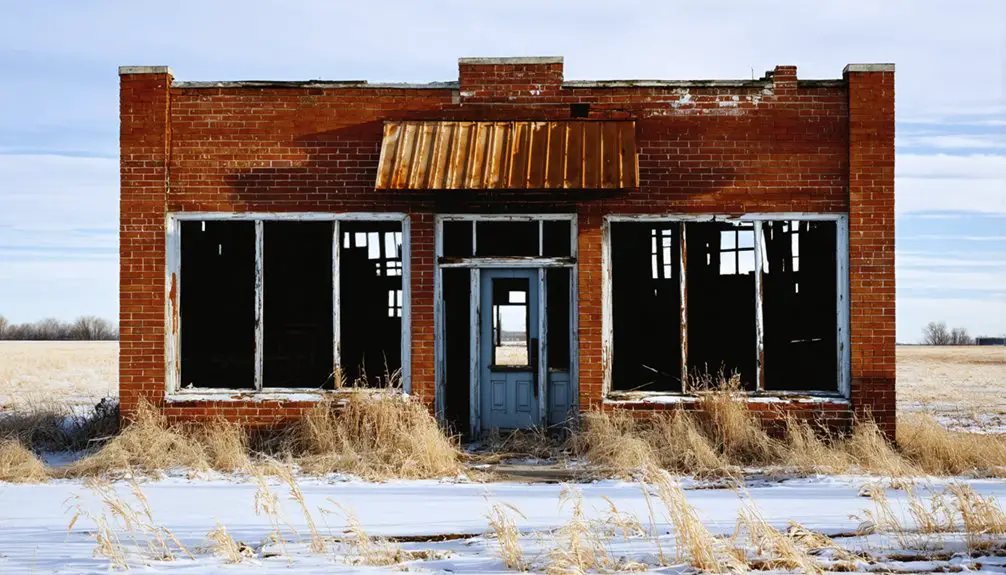You’ll find Aubry’s ghost town remains in modern-day Johnson County, Kansas, where it began as a Free-State settlement in 1857. During the Bleeding Kansas era, the town became a flashpoint for violence between pro-slavery and anti-slavery forces. After Quantrill’s raiders struck in 1862, the Union Army established a garrison there. The town’s decline accelerated after the Civil War, and today only scattered ruins and burial grounds mark where this contested border settlement once stood.
Key Takeaways
- Aubry was established in Kansas Territory during the 1850s, founded by William H. Brady and A. J. Gabbart near the Missouri border.
- The town became a strategic military post during the Civil War, housing Union troops to defend against Confederate raiders.
- Quantrill’s raid in 1862 left three residents dead and buildings blood-stained, leading to increased military presence.
- Without railroad connections and major trade routes, Aubry’s population declined as returning Civil War soldiers chose larger cities.
- The closure of the post office marked Aubry’s final transformation into a ghost town after years of economic decline.
Birth of a Border Town
While frontier settlement swept across Kansas Territory in the late 1850s, Aubry emerged as a strategically positioned border town in southeastern Johnson County.
You’ll find its origins traced to William H. Brady’s first land claim in February 1857, followed by the township’s official organization in May 1858. The town’s founders, including A. J. Gabbart and Brady, chose to name it after renowned Santa Fe trader François Xavier Aubry.
Early settlers quickly established crucial town infrastructure, building a schoolhouse that served multiple community functions. The site was officially surveyed in March 1858 when the Town Company formed.
You’d have witnessed the rapid development of essential services, including the first school district in summer 1858 and a post office by 1860. In May 1859, the growing community witnessed another milestone as the first church was organized to serve the spiritual needs of settlers.
Aubry’s location along the Oregon and Santa Fe Trails, plus its proximity to a military road connecting Fort Leavenworth to Fort Scott, secured its importance as a frontier gateway.
The Bleeding Kansas Era
During Bleeding Kansas, you’d find Aubry caught in the crossfire as Missouri border ruffians launched raids into the territory, targeting Free-State settlers and their properties.
Your chances of witnessing violence increased dramatically between 1854-1859, as pro-slavery forces used the town’s strategic location along the Santa Fe Trail to stage attacks deeper into Kansas Territory. The Kansas-Nebraska Act had sparked this violent guerrilla war by allowing settlers to determine slavery’s fate in the territory.
Free-State militias soon organized defensive positions around Aubry, transforming this once-peaceful border settlement into a flashpoint of territorial warfare. John Brown’s Pottawatomie Massacre in 1856 further intensified the violent clashes between pro-slavery and anti-slavery forces.
Border Violence Escalates
After the Kansas-Nebraska Act of 1854 introduced popular sovereignty to the territory, Aubry found itself caught in an escalating wave of violence between pro-slavery and anti-slavery factions.
Border disputes erupted as Missouri’s Border Ruffians clashed with Kansas Jayhawkers and Redlegs, turning the region into a powder keg that would help ignite the Civil War. Despite the intense media coverage, historical records show that actual deaths during the entire territorial period numbered only 56.
The violence manifested in several brutal ways:
- Pro-slavery forces raided towns and settlements, burning buildings and destroying abolitionist printing presses.
- John Brown’s militant abolitionists retaliated with deadly raids, including the infamous Pottawatomie Massacre.
- Local residents faced constant threats of assault, theft, and murder from both sides as the territory descended into guerrilla warfare.
You’d find electoral fraud rampant as both factions struggled to control Kansas’s destiny through legitimate and illegitimate means. The conflict intensified when New England abolitionists organized emigrant aid societies to help anti-slavery settlers move to Kansas.
Pro-Slavery Raids Intensify
As tensions reached a breaking point in May 1856, pro-slavery forces released their most brazen attack yet on the Free-State stronghold of Lawrence, Kansas.
You’d have witnessed Sheriff Samuel J. Jones leading his men in a calculated assault, positioning cannon on Mount Oread while blocking escape routes. Federal Marshal Donalson issued a public proclamation warning of resistance from Lawrence residents. Their pro-slavery tactics included methodically destroying the town’s Free-State infrastructure – burning the Free State Hotel and dumping newspaper printing presses into the Kansas River.
Though only one pro-slavery man died from falling debris, the attack’s aftermath proved devastating. The Republican press quickly labeled this violent incident the “Sack of Lawrence”.
The Lawrence raid sparked John Brown’s retaliatory killings at Pottawatomie Creek just days later, plunging the territory into a spiral of guerrilla warfare.
You’d soon see both sides abandoning restraint as violence erupted across the Kansas countryside.
Free-State Forces Respond
The Free-State settlers’ resistance intensified dramatically following the Lawrence raid, transforming from scattered opposition into an organized militant force. As tensions escalated, you’d find Free-State mobilization taking shape through groups like the Kansas Legion, which actively defended anti-slavery strongholds against proslavery aggression. The violence peaked when John Brown’s retaliatory killings at Pottawatomie Creek further inflamed the territory’s unrest.
Key elements of anti-slavery resistance included:
- Armed patrols guarding Free-State settlements from raiders
- Guerrilla-style counterattacks against proslavery forces
- Strategic defense networks linking Lawrence, Topeka, and Osawatomie
The Free-State forces didn’t limit their actions to military responses. They established their own government, rejected the authority of the proslavery legislature, and drafted progressive constitutions. Under the leadership of Charles Robinson as governor, they established a parallel government in Topeka to challenge proslavery rule.
Despite federal troops sometimes opposing their efforts, these determined settlers maintained control of key territories throughout the bloodiest periods of Bleeding Kansas.
Quantrill’s Raiders Strike
During the early evening of August 20, 1863, William Quantrill led approximately 310 guerrilla fighters across the Missouri-Kansas border near Aubry, having gathered his forces earlier near Missouri’s Blackwater River.
You’ll find it telling that the Union cavalry stationed at Aubry’s military post failed to mount an effective response, leaving the town vulnerable to the raiders’ swift guerrilla tactics.
The devastating consequences of this raid would echo through the region, as Quantrill’s men killed three citizens and looted the town on March 7, 1862.
The raid aftermath heightened tensions along the border and foreshadowed the infamous Lawrence Massacre. While smaller in scale than later attacks, this strategic strike demonstrated the raiders’ ability to navigate the rural terrain and exploit weak defensive positions.
Military Post and Union Response
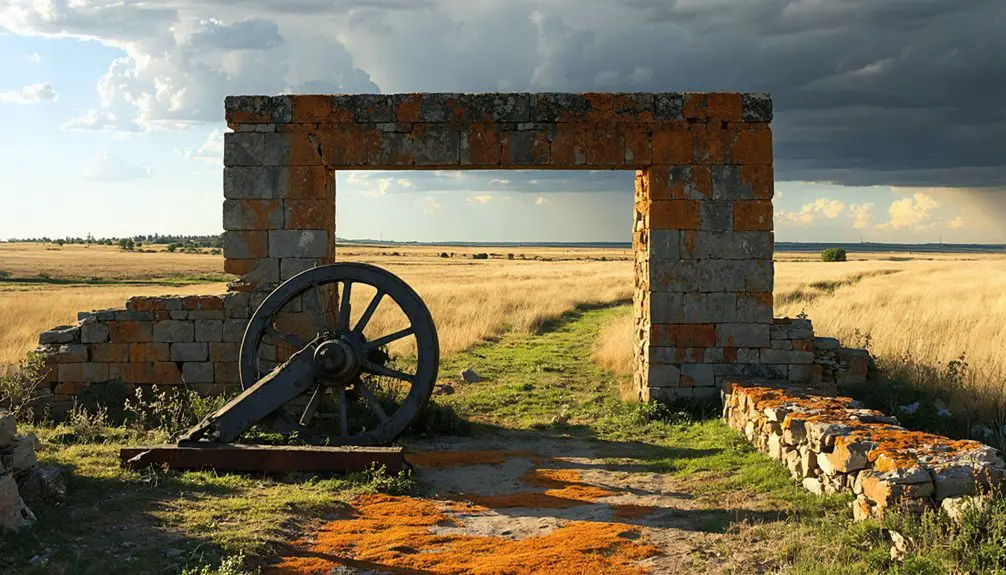
Following the devastating raid, you’ll find that Union forces established a military post at Aubry in March 1862, starting with Company E of the 8th Kansas Volunteers under Captain John Greelish.
You’ll see how the post’s strategic location along the Kansas-Missouri border made it essential for monitoring Confederate guerrilla movements and protecting the military road between Fort Leavenworth and Fort Scott.
While Union troops engaged in several skirmishes with Quantrill’s Raiders, the post’s effectiveness came into question when Captain Pike failed to intercept Quantrill’s force of 400 men passing within sight of Aubry in August 1863.
Union Post Establishment 1862
Reacting to William C. Quantrill’s devastating raid on March 7, 1862, Union forces quickly established a garrison at Aubry, Kansas.
You’ll find that Quantrill’s impact led directly to the deployment of Company E, 8th Regiment of Kansas Volunteers under Capt. John Greelish’s command to protect the border settlement.
- Blood-stained buildings and ransacked shops marked the aftermath of Quantrill’s raid, with three residents dead and countless belongings stolen.
- Newly-arrived Union soldiers formed battle lines just two days later, successfully driving off thirty of Quantrill’s men in a fierce skirmish.
- Victory prompted military leaders to strengthen Aubry’s defenses, later transferring command to Company D of the 11th Kansas Infantry under Lt. Dick Rooks, a notorious Red Leg fighter.
Strategic Border Defense Operations
To strengthen border defenses after Quantrill’s devastating raid, Union forces established a robust military presence at Aubry that evolved throughout the Civil War.
You’ll find that initial military logistics centered around Company E of the 8th Kansas Volunteers under Capt. John Greelish, followed by additional deployments including Company D of the 11th Kansas Infantry.
The post’s border fortifications included a guardhouse, while two cavalry companies totaling 72 troops under Capt. Joshua Pike maintained security by 1863.
You can trace how the 11th Kansas Cavalry consistently defended Aubry from late 1863 through September 1864, using it as a staging area to intercept guerrilla movements.
Despite a brief abandonment during Price’s Missouri Raid, the strategic outpost remained active until May 1865, protecting Free-State sympathizers and crucial transportation routes.
Skirmishes Against Quantrill’s Raiders
After Quantrill’s devastating raid on March 7, 1862, which left three residents dead and significant property stolen, Union forces swiftly established a military garrison at Aubry.
Under Capt. John Greelish’s command, Company E of the 8th Kansas Volunteers arrived on March 10, engaging in skirmish tactics against Confederate guerrillas. The post’s strength increased when Major E. F. Schneider took command with additional reinforcements.
You’ll find these vivid scenes from the Union’s defensive operations:
- Union troops defeating 30 of Quantrill’s men in a fierce skirmish just two days after establishing the post
- Lt. Dick Rooks’ Company D of the 11th Kansas Infantry manning the fortification through winter
- Capt. Pike’s cavalry companies patrolling with 72 men, though they failed to intercept Quantrill’s force of 400 en route to Lawrence
Life During Wartime
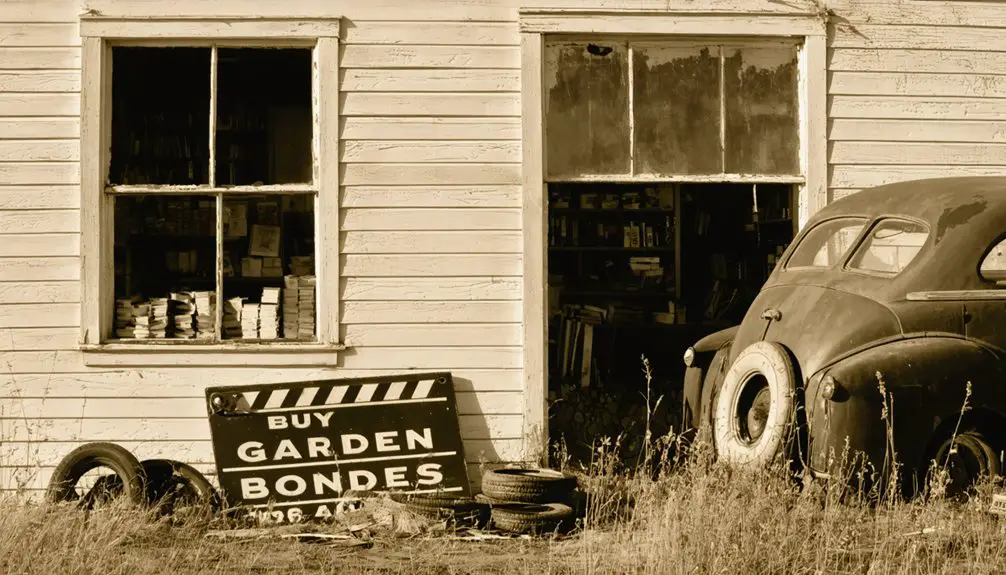
When the Civil War erupted in 1861, Aubry’s peaceful existence transformed into a tense battleground caught between Union forces and Confederate guerrilla raiders.
You’d have witnessed civilian resilience as families endured constant threats from Quantrill’s raiders, who repeatedly targeted the town, killing residents and destroying property.
Economic disruption paralyzed daily life as trade slowed and normal activities became dangerous ventures.
Local families buried their dead under cedar trees after raids, including three men killed in March 1862.
You couldn’t freely express political views without risking violent reprisals from either side.
While Union troops stationed at the military post offered some protection, they couldn’t prevent all guerrilla incursions.
Residents lived under persistent strain, with the town’s position along the Military Road making it a continued target for warfare.
The Town’s Gradual Disappearance
Since the Civil War had battered Aubry’s spirit and infrastructure, the town’s decline accelerated through a devastating chain of events.
You’d have witnessed a stark population decline as returning soldiers chose larger cities, while economic isolation gripped the remaining residents. Without rail connections or major trade routes, Aubry couldn’t compete with growing urban centers like Kansas City and Olathe.
- Empty storefronts collected dust as businesses shuttered their doors
- Farm families gradually sold their land and moved away
- The post office’s closure signaled the final death knell for community life
The town’s position along the troubled Kansas-Missouri border, once strategic, now worked against it.
As infrastructure and opportunities developed elsewhere, Aubry faded into the surrounding countryside, becoming little more than a memory.
Archaeological and Physical Remains
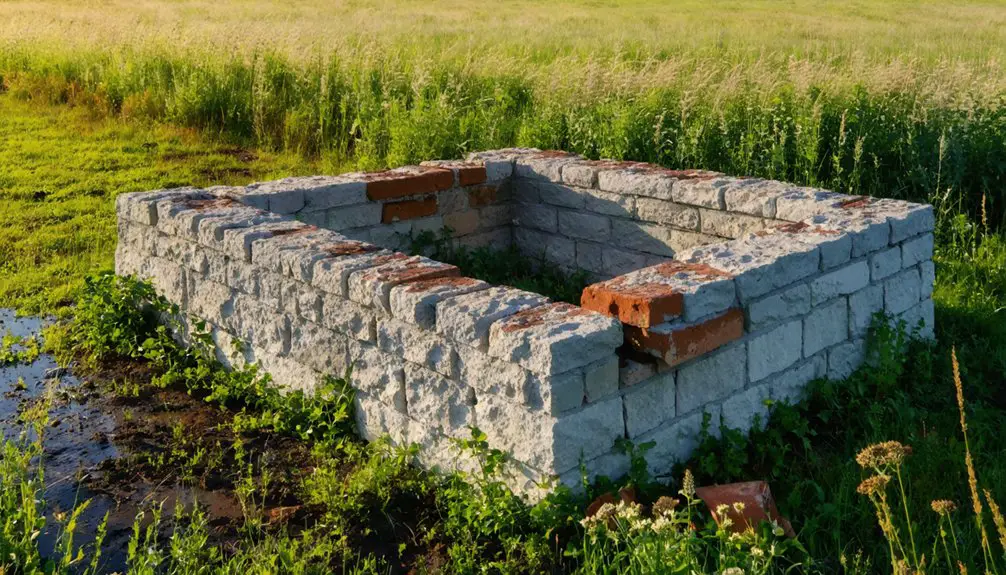
Today’s urban sprawl of Overland Park, Kansas, has consumed most physical traces of Aubry’s existence, but scattered remnants tell the town’s story.
You’ll find the town’s archaeological significance in deeply buried Clovis-period artifacts, including quartzite tools and prehistoric remains dating back 11,000 years.
The most tangible link to Aubry’s past stands in its historic cemetery, where weathered gravestones chronicle the community’s burial practices from the 1850s onward.
Three distinctive cedar trees mark where Civil War casualties rest, while nearby fossil deposits contain bison bones and extinct snail shells.
At Fort Aubrey near Syracuse, you can still spot three clusters of dugout depressions, though no buildings remain standing.
Amateur archaeologists occasionally uncover glass shards and metal fragments, hinting at the rich historical deposits that lie beneath modern development.
Stories From the Cemetery
After Quantrill’s Raiders struck Aubry on March 7, 1862, the violent raid claimed three men’s lives and established what would become Aubry Cemetery.
Today, you’ll find Cemetery Legends surrounding the three cedar trees where those first victims were laid to rest. These trees stand as silent witnesses to the border warfare that once raged through Johnson County.
- Haunting Tales emerge from the unmarked graves, their stories lost when fire destroyed the original records.
- You’ll discover headstones telling the stories of pioneers and settlers aged 3 to 100 years old.
- The cemetery grounds whisper of Union soldiers who once protected this strategic position during the Civil War.
Walking these grounds today, you’re treading on layers of history preserved despite Overland Park’s urban expansion around it.
Modern Historical Significance
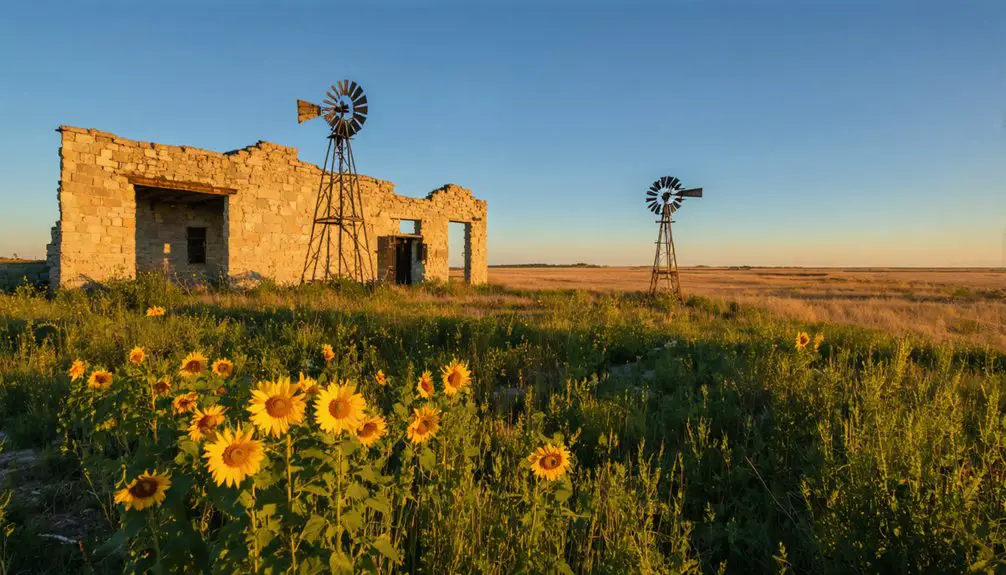
While Aubry’s physical presence has largely faded into Johnson County’s modern landscape, its historical significance endures through its pivotal role in the Civil War and the broader Kansas-Missouri border conflicts.
Today, you’ll find a thriving community of about 5,400 residents where this once-strategic military post stood.
Though historical preservation efforts remain limited, Aubry’s legacy lives on through documented accounts of Quantrill’s Raiders, Union troop movements, and the fierce battles that shaped Kansas’ path to freedom.
The area’s tourism potential stems from its connection to the Civil War era, particularly its role during the Bleeding Kansas period. You can explore this heritage through local historical societies and the Aubry Cemetery Union, where the town’s complex story of conflict and resilience continues to resonate.
Frequently Asked Questions
What Were the Primary Occupations of Aubry’s Earliest Settlers?
Like seeds scattered across fertile soil, you’d find settlers primarily engaged in farming practices, early commerce along trade routes, military defense roles, and transport-related work supporting the Santa Fe Trail.
How Many Families Remained in Aubry After the Civil War Ended?
You won’t find exact post war demographics, but historical evidence suggests only a handful of families remained, as widespread family migration occurred following the intense border warfare and raids.
Were There Any Native American Settlements Near Aubry Before Its Establishment?
Thousands of stories lie buried beneath your feet! While native tribes like the Shawnee and Cherokee lived in Johnson County, there’s no concrete archaeological findings of permanent settlements directly at Aubry’s location.
What Happened to Aubry’s Original Town Records and Documents?
You’ll find that Aubry’s lost archives likely met destruction during Civil War raids and border conflicts. No direct evidence of historical preservation exists, suggesting records vanished amid the town’s violent decline.
Did Any Prominent Historical Figures Besides Quantrill Have Connections to Aubry?
Beyond shadows of the past, you’ll find Francois Xavier Aubry, the town’s namesake trader, Captain John Greelish’s Union garrison command, and Mr. Treble’s brave warning that cost him his life.
References
- https://legendsofkansas.com/aubry-kansas/
- https://metrovoicenews.com/ghost-towns-of-kansas-city/
- https://jocoksgw.cottonhills.net/history/past-towns.html
- https://civilwaronthewesternborder.org/map/aubry-post-kansas
- https://legendsofkansas.com/johnson-county-extinct-towns/
- https://www.civilwaronthewesternborder.org/timeline/quantrills-raid-aubry
- https://jocohistory.wordpress.com/2015/04/23/caught-in-the-crossfire-johnson-county-the-civil-war/
- https://lostkansas.ccrsdigitalprojects.com/sites/lostkansas/files/private_static/2022-12/LT_JO_Aubry_Edwards.pdf
- https://www.battlefields.org/learn/articles/bleeding-kansas
- https://www.blackpast.org/african-american-history/bleeding-kansas-1854-1861/
